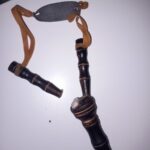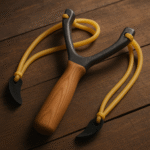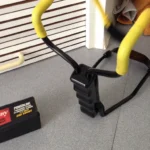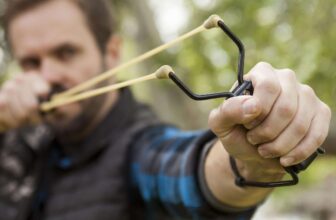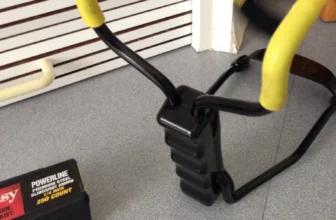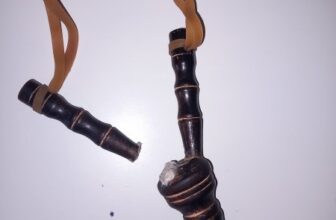Once you’ve selected the perfect slingshot from the ultimate guide to slingshots, the next challenge is finding engaging targets that will actually improve your shooting skills. These ten creative DIY target setups cost virtually nothing to build but provide hours of challenging practice that will sharpen your accuracy and technique.
Target #1: The Classic Paper Plate Progressive
Materials Needed
- 6-8 paper plates of different sizes
- Black marker
- Clothespins or clips
- String or wire fence
Setup Instructions
Create concentric circles on each plate, starting with dinner-plate size and working down to saucer-sized plates. Draw scoring rings with point values: outer ring (1 point), middle ring (3 points), bullseye (5 points).
Skill Development
This progressive system builds fundamental accuracy by gradually reducing target size as your skills improve. Start at 10 feet with the largest plate, then move back or switch to smaller plates as you achieve consistent hits.
Pro Variation
Advanced shooters can try the “graduation system” – you can’t move to a smaller target until you hit the current target 5 times in a row. This builds the consistency needed for avoiding common slingshot mistakes.
Target #2: Bottle Cap Precision Challenge
Materials Needed
- 20-30 bottle caps (plastic or metal)
- Hot glue gun or strong adhesive
- Large cardboard backing
- Different colored spray paint (optional)
Setup Instructions
Arrange bottle caps on the cardboard in various patterns – clusters, lines, or random scatter. Use different colors to assign point values or create specific shooting sequences.
Skill Development
Small targets like bottle caps force you to develop precise aim and consistent form. The variety of arrangements keeps practice sessions interesting while building the accuracy needed for hunting scenarios.
Scoring System
- Silver caps: 2 points
- Gold caps: 5 points
- Red caps: 10 points
- Sequence bonus: Hit 3 caps in predetermined order for 25 points
Target #3: Swinging Pendulum Targets
Materials Needed
- Tennis balls or plastic bottles
- Strong string or rope
- Tree branch or overhead support
- Spray paint for visibility
Setup Instructions
Hang targets at different lengths to create varying swing speeds. Paint bright colors or patterns to improve visibility. Start pendulums swinging before taking shots.
Skill Development
Moving targets dramatically improve your timing and prediction skills. This setup mimics hunting conditions where targets rarely stand perfectly still.
Difficulty Progression
- Beginner: Slow, predictable pendulum motion
- Intermediate: Multiple pendulums at different speeds
- Advanced: Irregular swing patterns created by varying string lengths
According to research from International Practical Shooting Confederation, moving target practice improves static target accuracy by an average of 25%.
Target #4: Cardboard Castle Siege
Materials Needed
- Large cardboard boxes
- Tape or glue
- Toy soldiers or paper cutouts
- Different colored markers
Setup Instructions
Build a castle structure with battlements, towers, and defensive positions. Place “defenders” at various points throughout the structure. Create point values for different targets and structural elements.
Skill Development
This imaginative setup combines accuracy with strategy, as you must plan which targets to engage first to “breach the defenses.” Great for maintaining interest during longer practice sessions.
Expansion Ideas
Create multiple castles for tournament-style competition or add story elements that make practice feel like an adventure rather than repetitive drilling.
Target #5: Paint Can Thunder Range
Materials Needed
- Empty paint cans (various sizes)
- Stones or marbles for noise
- Bright spray paint
- Different elevation platforms
Setup Instructions
Place a few stones in each can to create satisfying noise when hit. Paint cans in bright colors and arrange at different heights using boxes, stumps, or platforms.
Skill Development
The immediate audio feedback helps you understand shot placement even at longer distances. Different can sizes provide varying difficulty levels within the same setup.
Advanced Configuration
Create sequences where you must hit cans in specific orders, or set up “falling domino” chains where one can knocks into another for bonus points.
Target #6: String and Balloon Aerial Challenge
Materials Needed
- Balloons (various sizes)
- Strong thread or fishing line
- Clips or clothespins
- Overhead attachment points
Setup Instructions
Hang balloons at different heights and distances using nearly invisible fishing line. Create clusters and individual targets at varying elevations.
Skill Development
Balloon targets provide instant visual feedback and help develop the precise aim needed for proper ammunition selection. The pop provides satisfying confirmation of hits even at distance.
Wind Training
On breezy days, balloons become excellent moving targets that help develop skills for real-world outdoor shooting conditions.
Target #7: Multi-Level Staircase Setup
Materials Needed
- Cardboard boxes of different sizes
- Small targets (cups, cans, bottles)
- Tape and markers
- Point value labels
Setup Instructions
Stack boxes to create a staircase effect, placing targets at each level. Higher levels should have higher point values to encourage challenging shots.
Skill Development
Elevation changes force you to adjust your aim and trajectory, developing the ballistic understanding needed for varied shooting scenarios.
Competition Format
Create a “king of the mountain” challenge where you must clear each level before advancing to the next, with bonus points for clearing entire levels without misses.
Target #8: Rotating Wheel of Fortune
Materials Needed
- Large bicycle wheel or hula hoop
- Cardboard sections
- Central pivot mechanism
- Bright paints and markers
Setup Instructions
Divide the wheel into sections with different point values and colors. Create a simple pivot system that allows the wheel to spin freely. Give it a spin before each shot.
Skill Development
This challenging target improves timing and prediction skills while adding excitement to practice sessions. The rotating motion requires precise timing similar to hunting moving game.
Variation Ideas
Create different wheel speeds, add small targets mounted on the rim, or use multiple wheels spinning in opposite directions for advanced challenges.
Target #9: The Hunter’s Field Course
Materials Needed
- Various natural materials (sticks, leaves, logs)
- Animal silhouette cutouts
- Camouflage paint or materials
- Distance markers
Setup Instructions
Create realistic hunting scenarios using natural cover and concealment. Place animal silhouettes at various distances and angles, partially hidden behind natural obstacles.
Skill Development
This setup develops the skills needed for actual hunting situations, including target identification, range estimation, and shooting through natural cover.
Realism Training
Practice from different shooting positions (standing, kneeling, supported) to simulate real hunting scenarios. This preparation is essential for those interested in UK slingshot hunting regulations.
Target #10: Competition-Style Point System
Materials Needed
- Regulation-sized target faces
- Scoring sheets
- Timer (optional)
- Distance markers
Setup Instructions
Set up formal scoring targets at standardized distances (10, 15, and 20 meters). Create official scoring sheets to track progress over time.
Skill Development
Formal scoring systems help track improvement objectively and prepare shooters for actual competitions or certification programs.
Record Keeping
Maintain shooting logs to identify patterns, track improvement, and plan practice sessions. Consistent record keeping reveals which techniques work best for your shooting style.
Safety Setup Guidelines
Essential Safety Requirements:
Backstop: Every target setup must have an adequate backstop that will stop projectiles completely. Thick plywood, hay bales, or earth berms work well.
Clear Zones: Maintain clear areas of at least 45 degrees on each side of your shooting lane to account for misses or ricochets.
Range Marking: Use bright tape or cones to mark safe shooting positions and target areas clearly.
Eye Protection: Always wear safety glasses when shooting, regardless of target type or distance.
Legal Considerations
Before setting up any target range, verify local regulations regarding projectile shooting. Some areas have restrictions on slingshot use even on private property.
Maximizing Practice Value
The key to effective target practice isn’t just hitting targets – it’s building the muscle memory and consistency that translate to real shooting situations. Rotate between different target types to develop well-rounded skills, and always focus on proper form over rapid shooting.
Start with easier setups and gradually increase difficulty as your accuracy improves. Remember that quality practice with proper technique beats quantity shooting with poor habits. For additional technique refinement, review our guide on common shooting mistakes to ensure your practice reinforces good habits rather than bad ones.
These DIY targets cost almost nothing to build but provide the varied, engaging practice needed to develop serious slingshot skills. Whether you’re preparing for hunting, competition, or simply enjoying recreational shooting, these creative setups will keep your practice sessions challenging and fun.

